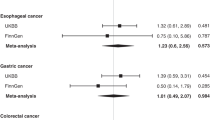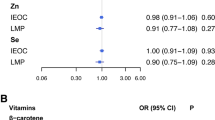Abstract
Background/Objective:
Folates are essential for DNA synthesis and methylation, and thus may have a role in carcinogenesis. Limited evidence suggests folate-containing foods might protect against some cancers and may partially mitigate the increased risk of breast cancer associated with alcohol intake, but there is little information regarding ovarian cancer. Our aim was to evaluate the role of folate and related micronutrients, polymorphisms in key folate-metabolising genes and environmental factors in ovarian carcinogenesis.
Subjects/Methods:
Participants in the Australian Ovarian Cancer Study (1363 cases, 1414 controls) self-completed risk factor and food-frequency questionnaires. DNA samples (1638 cases, 1278 controls) were genotyped for 49 tag single-nucleotide polymorphisms (SNPs) in the methylene tetrahydrofolate reductase (MTHFR), methionine synthase (MTR) and MTR reductase (MTRR) genes. Logistic regression models were used to generate adjusted odds ratios and 95% confidence intervals.
Results:
We saw no overall association between the intake of folate, B vitamins or other methyl donors and ovarian cancer risk, although increasing folate from foods was associated with reduced risk among current smokers (Ptrend=0.03) and folic acid intake was associated with borderline significant increased risks among women who consumed ⩾1 standard alcoholic drinks/day (odds ratio (OR)=1.64; 95% confidence interval (CI) 1.05–2.54, Ptrend=0.05). Two SNPs (rs7365052, rs7526063) showed borderline significant inverse associations with ovarian cancer risk; both had very low minor allele frequencies. There was little evidence for interaction between genotype and micronutrient intake or for variation between different histological subtypes of ovarian cancer.
Conclusions:
Our data provide little evidence to support a protective role for folate in ovarian carcinogenesis but suggest further evaluation of the joint effects of folic acid and alcohol is warranted.
This is a preview of subscription content, access via your institution
Access options
Subscribe to this journal
Receive 12 print issues and online access
$259.00 per year
only $21.58 per issue
Buy this article
- Purchase on Springer Link
- Instant access to full article PDF
Prices may be subject to local taxes which are calculated during checkout
Similar content being viewed by others
References
Australian Bureau of Statistics (2006). 2004–05 National Health Survey: summary of results.
Beesley J, Jordan SJ, Spurdle AB, Song H, Ramus SJ, Kjaer SK et al. (2007). Association between single-nucleotide polymorphisms in hormone metabolism and DNA repair genes and epithelial ovarian cancer: results from two Australian studies and an additional validation set. Cancer Epidemiol Biomarkers Prev 16, 2557–2565.
Bidoli E, La Vecchia C, Talamini R, Negri E, Parpinel M, Conti E et al. (2001). Micronutrients and ovarian cancer: a case-control study in Italy. Ann Oncol 12, 1589–1593.
Cole BF, Baron JA, Sandler RS, Haile RW, Ahnen DJ, Bresalier RS et al. (2007). Folic acid for the prevention of colorectal adenomas: a randomized clinical trial. J Am Med Assoc 297, 2351–2359.
Curtin K, Bigler J, Slattery ML, Caan B, Potter JD, Ulrich CM (2004). MTHFR C677T and A1298C polymorphisms: diet, estrogen, and risk of colon cancer. Cancer Epidemiol Biomarkers Prev 13, 285–292.
Ebbing M, Bonaa KH, Nygard O, Arnesen E, Ueland PM, Nordrehaug JE et al. (2009). Cancer incidence and mortality after treatment with folic acid and vitamin B12. J Am Med Assoc 302, 2119–2126.
Food Standards Australia New Zealand (2007). NUTTAB 2006—Australian Food Composition Tables. Food Standards Australia New Zealand: Canberra.
Halsted CH, Villanueva JA, Devlin AM, Chandler CJ (2002). Metabolic interactions of alcohol and folate. J Nutr 132, 2367S–2372S.
Hemminger BM, Saelim B, Sullivan PF (2006). TAMAL: an integrated approach to choosing SNPs for genetic studies of human complex traits. Bioinformatics 22, 626–627.
Ibiebele TI, Parekh S, Mallitt KA, Hughes MC, O’Rourke PK, Webb PM (2009). Reproducibility of food and nutrient intake estimates using a semi-quantitative FFQ in Australian adults. Public Health Nutr 12, 2359–2365.
Kelemen L, Sellers T, Vierkant R, Harnack L, Cerhan J (2004). Association of folate and alcohol with risk of ovarian cancer in a prospective study of postmenopausal women. Cancer Causes Control 15, 1085–1093.
Kelemen LE, Sellers TA, Schildkraut JM, Cunningham JM, Vierkant RA, Pankratz VS et al. (2008). Genetic variation in the one-carbon transfer pathway and ovarian cancer risk. Cancer Res 68, 2498–2506.
Kotsopoulos J, Hankinson SE, Tworoger SS (2010). Dietary betaine and choline intake are not associated with risk of epithelial ovarian cancer. Eur J Clin Nutr 64, 111–114.
Kushi LH, Mink PJ, Folsom AR, Anderson KE, Zheng W, Lazovich D et al. (1999). Prospective study of diet and ovarian cancer. Am J Epidemiol 149, 21–31.
Larsson SC, Giovannucci E, Wolk A (2004). Dietary folate intake and incidence of ovarian cancer: the Swedish Mammography Cohort. J Natl Cancer Inst 96, 396–402.
Marks GC, Hughes MC, van der Pols JC (2006a). The effect of personal characteristics on the validity of nutrient intake estimates using a food-frequency questionnaire. Public Health Nutr 9, 394–402.
Marks GC, Hughes MC, van der Pols JC (2006b). Relative validity of food intake estimates using a food frequency questionnaire is associated with sex, age, and other personal characteristics. J Nutr 136, 459–465.
Mason JB, Dickstein A, Jacques PF, Haggarty P, Selhub J, Dallal G et al. (2007). A temporal association between folic acid fortification and an increase in colorectal cancer rates may be illuminating important biological principles: a hypothesis. Cancer Epidemiol Biomarkers Prev 16, 1325–1329.
McCann SE, Freudenheim JL, Marshall JR, Graham S (2003). Risk of human ovarian cancer is related to dietary intake of selected nutrients, phytochemicals and food groups. J Nutr 133, 1937–1942.
Merritt MA, Green AC, Nagle CM, Webb PM (2008). Talcum powder, chronic pelvic inflammation and NSAIDs in relation to risk of epithelial ovarian cancer. Int J Cancer 122, 170–176.
Navarro Silvera SA, Jain M, Howe GR, Miller AB, Rohan TE (2006). Dietary folate consumption and risk of ovarian cancer: a prospective cohort study. Eur J Cancer Prev 15, 511–515.
Pan SY, Ugnat A-M, Mao Y, Wen SW, Johnson KC, The Canadian Cancer Registries Epidemiology Research Group (2004). A case-control study of diet and the risk of ovarian cancer. Cancer Epidemiol Biomarkers Prev 13, 1521–1527.
Pandeya N, Williams GM, Green AC, Webb PM, Whiteman DC (2009). Do low control response rates always affect the findings? Assessments of smoking and obesity in two Australian case-control studies of cancer. Aust N Z J Public Health 33, 312–319.
Pelucchi C, Mereghetti M, Talamini R, Negri E, Montella M, Ramazzotti V et al. (2005). Dietary folate, alcohol consumption, and risk of ovarian cancer in an Italian case-control study. Cancer Epidemiol Biomarkers Prev 14, 2056–2058.
Salazar-Martinez E, Lazcano-Ponce EC, Gonzalez Lira-Lira G, Escudero-De los Rios P, Hernandez-Avila M (2002). Nutritional determinants of epithelial ovarian cancer risk: a case-control study in Mexico. Oncology 63, 151–157.
Sharp L, Little J (2004). Polymorphisms in genes involved in folate metabolism and colorectal neoplasia: a HuGE review. Am J Epidemiol 159, 423–443.
Tworoger SS, Hecht JL, Giovannucci E, Hankinson SE (2006). Intake of folate and related nutrients in relation to risk of epithelial ovarian cancer. Am J Epidemiol 163, 1101–1111.
USDA (2008). USDA database for the choline content of common foods, release 2: USDA.
WCRF/AICR (2007). Food, Nutrition, Physical Activity, and the Prevention of Cancer: A Global Perspective. AICR: Washington DC.
Willett W, Sampson L, Stampfer M, Rosner B, Bain C, Witschi J et al. (1985). Reproducibility and validity of a semiquantitative food frequency questionnaire. Am J Epidemiol 122, 51–65.
Willett W, Stampfer MJ (1986). Total energy intake: implications for epidemiologic analyses. Am J Epidemiol 124, 17–27.
Acknowledgements
We acknowledge the cooperation of the following institutions: New South Wales: John Hunter Hospital, North Shore Private Hospital, Royal Hospital for Women, Royal North Shore Hospital, Royal Prince Alfred Hospital, Westmead Hospital, New South Wales Cancer Registry; Queensland: Mater Misericordiae Hospital, Royal Brisbane and Women's Hospital, Townsville Hospital, Wesley Hospital, Queensland Cancer Registry; South Australia: Flinders Medical Centre, Queen Elizabeth II, Royal Adelaide Hospital, South Australian Cancer Registry; Tasmania: Royal Hobart Hospital; Victoria: Freemasons Hospital, Mercy Hospital For Women, Monash Medical Centre, Royal Women's Hospital, Victorian Cancer Registry; and Western Australia: King Edward Memorial Hospital, St John of God Hospitals Subiaco, Sir Charles Gairdner Hospital, Western Australia Research Tissue Network, Western Australia Cancer Registry. We also acknowledge the contribution of the study nurses and research assistants, and we would like to thank all of the women who participated in the study. These analyses were funded by the Queensland Cancer Council (389880). The Australian Ovarian Cancer Study was supported by the US Army Medical Research and Materiel Command under DAMD17-01-1-0729, the Cancer Council Tasmania and the Cancer Foundation of Western Australia; the Australian Cancer Study was supported by the National Health and Medical Research Council (NHMRC) of Australia (199600). PM Webb and G Chenevix-Trench are supported by Fellowships from the NHMRC.
Full membership of the Australian Ovarian Cancer Study Group is listed at http://www.aocstudy.org/; the Australian Cancer Study Investigators are A Green, P Parsons, N Hayward, P Webb and D Whiteman.
Author information
Authors and Affiliations
Consortia
Corresponding author
Ethics declarations
Competing interests
The authors declare no conflict of interest.
Additional information
Supplementary Information accompanies the paper on European Journal of Clinical Nutrition website
Supplementary information
Rights and permissions
About this article
Cite this article
Webb, P., Ibiebele, T., Hughes, M. et al. Folate and related micronutrients, folate-metabolising genes and risk of ovarian cancer. Eur J Clin Nutr 65, 1133–1140 (2011). https://doi.org/10.1038/ejcn.2011.99
Received:
Revised:
Accepted:
Published:
Issue Date:
DOI: https://doi.org/10.1038/ejcn.2011.99
Keywords
This article is cited by
-
Intake of vitamins A, C, and E and folate and the risk of ovarian cancer in a pooled analysis of 10 cohort studies
Cancer Causes & Control (2015)
-
Genetic polymorphisms of methylenetetrahydrofolate reductase (MTHFR) gene Ala222Val and susceptibility to ovary cancer: a systematic review and meta-analysis
Tumor Biology (2014)
-
The association between MTHFR C677T polymorphism and ovarian cancer risk: a meta-analysis of 18, 628 individuals
Molecular Biology Reports (2013)
-
Folate intake and MTHFR polymorphism C677T is not associated with ovarian cancer risk: evidence from the meta-analysis
Molecular Biology Reports (2013)
-
MTHFR polymorphisms and ovarian cancer risk: a meta-analysis
Molecular Biology Reports (2012)



